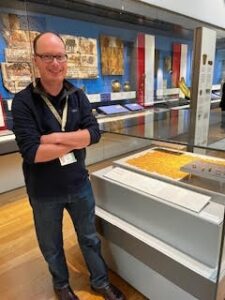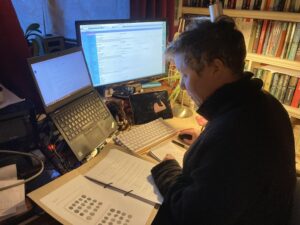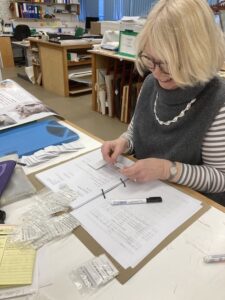
Exhibition on Roman Oxfordshire, Oxfordshire Museum, photo Dina Sikorska, courtesy Oxfordshire Museum.
Angie Bolton is one of those lucky few people who genuinely seems to enjoy her work. Her passion for community-based cultural heritage preservation has come in handy first as a Finds Liaison Officer with the Portable Antiquity Scheme (PAS) and now as the Curator of Archaeology for the Oxfordshire Museum in Woodstock, Oxfordshire.
The PAS and the Treasure Act were rolled out in the late 1990s to ensure that increasing numbers of coins and other artifacts that were uncovered with metal detectors would be properly recorded. The Treasure Act was also meant to ensure that both the British and local museums receive a right of first refusal over objects deemed to be of national or local significance. As a Finds Liaison Officer, Angie was charged with working with metal detectorists to help them record their finds. As Curator of Archaeology, Angie is now primarily responsible for the preservation, study and display of artifacts found in her museum which is located in a largely rural county in the South East of England that nonetheless can boast of being the home of world famous Oxford University.

Dr. Michael Lewis, British medieval archaeologist and Head of the Portable Antiquities Scheme operated by the British Museum. Photo courtesy Michael Lewis.
The primary challenge in Angie’s early days was convincing skeptical metal detectorists that Finds Liaisons Officers were not out to spy on them for the authorities, but rather were there to help them record their finds so that the public could learn more about local history. In traditional British fashion, some of this convincing took place over a pint of bitter in the local pub. More recently as Curator of archaeology, Angie has faced a happy challenge related to the success of the Treasure Act and PAS in the last 27 years. With far more items being reported, there is far more material available worth exercising a local museum’s rights of first refusal under the Treasure Act to purchase. Of course, this is where the challenge comes in, locating the money to pay finders “fair market value” for any material Angie’s Museum wants to retain.
Angie’s institution can’t afford to purchase everything so criteria for selecting items for possible acquisition have been developed. These include whether the object “has a good story to tell,” “its research potential” and its “condition” or “displayablity.” There is no dedicated funding as such. Instead, most funding comes from donations and grants from “The Art Fund,” “The Friends of the Oxfordshire Museum,” local businesses, and parish councils.

Entry record of a coin of Honorius, CE 395-402, Portable Antiquities Scheme.
Given the inevitable shortfalls, Angie has had to be resourceful in identifying other sources of funding, including soliciting donations at lectures and other events. The wide net she has cast even led her across the pond to the Ancient Coin Collectors Guild (ACCG), an American advocacy group that has championed the good the PAS had done on its website and in testimony before the U.S. State Department’s Cultural Property Advisory Committee (CPAC). CPAC reviews and makes recommendations to the State Department decision maker about cultural property agreements that authorize import restrictions on cultural goods. One of the criteria the decision maker is required to consider is whether “less drastic measures” can be adopted before such import restrictions are placed on common items like coins. That’s where ACCG’s advocacy about the Treasure Act and PAS comes in, albeit with little success given the State Department’s inclination to sign these agreements as “soft power” measures.

Randolph J. Myers is a Director of the ACCG, a specialist in coins and the cultural and political history of the Roman Republic and Roman Empire. Photo courtesy Randolph Myers.
After reviewing its website, Angie solicited the ACCG to help purchase one of the hoards she had identified for possible accession by her museum. After some discussion, Angie and the ACCG decided that the best way to reach her goal was for Angie to give a presentation about the Treasure Act and PAS for ACCG members that could be used as a fundraiser. Angie was joined in this endeavor by Michael Lewis, the head of the PAS at the British Museum, and Randy Myers, an ACCG board member and admirer of the PAS who has testified on the ACCG’s behalf before CPAC. ACCG Board Member and “Careful Collector” author Peter Tompa served as moderator.
Cultural Property News prepared a detailed report about the June 6, 2024 webinar, entitled, “A Closer Look at the Portable Antiquities Scheme.” During that program, Michael first provided an overview of the Treasure Act and PAS, highlighting its success in recording 35,000 objects in 2024 alone. Angie then discussed how finds have been displayed at her museum, focusing on the late 3rd century Stoke Lynde coin hoards I and II. Finally, Randy discussed how the Treasure Act and the PAS help both preserve cultural heritage as well as encourage lawful collecting and the knowledge and appreciation of ancient cultures.

Angie Bolton cataloging coins – the work never stops. Photo courtesy Angie Bolton.
After the webinar, the ACCG board voted unanimously to donate $1,000 to the Oxfordshire Museum so Angie could purchase one of the hoards she had been eyeing, with the ACCG then asking its members to help fund that donation. As a result of this effort, the Museum was able to acquire a late Roman coin hoard, found in the parish of Crawley, Oxfordshire. The hoard consists of 34 silver siliquae coins minted between 355 and 402 AD. Such coins, which are about the size of a US dime, represent some of the last Roman coins to be minted in the Western Roman Empire. Many of the coins were heavily clipped along their edge with shears to reduce their size, which suggests an effort to recover some of their silver content for other purposes or perhaps to make them compatible in size with later Anglo-Saxon “sceat” coinage.
The siliqua were issued on behalf of Emperors Valens, Theodosius I, Gratian, Arcadius and Honorius and were minted at Trier, Lyon, Arles, and Milan, a testament to the wide-ranging circulation of such coins. Angie and her colleagues thought the hoard was worth acquiring because the museum had no hoard of siliqua in its collection and displaying such coins will both complement other 5th century objects on display as well as tell the story that the end of Roman rule did not end trade relationships with Continental Europe. Angie and her team have already accessioned and catalogued the hoard and hope to put it on display in the Museum in 2025.
As a bonus, the museum also hopes to use any funds left over from the purchase as seed money to help acquire an Early Medieval gold pendant. The pendant features an Early Medieval solidus of Chlotar II (AD 584–629) struck in Marseille, dating to the period c. 613–29 AD, which has been converted to jewellery with the soldering of a gold loop.
If any CPN reader would like to contribute monies to help fund this acquisition, Angie and her colleagues at the Oxfordshire Museum would be happy to hear from you through the Oxfordshire Museum’s website.
Next Installment: What the Second Trump Administration Might Mean for Collectors
Further Information about the Treasure Act and Portable Antiquities Scheme:
Kate Fitz Gibbon, A Closer Look at the Portable Antiquities Scheme, Cultural Property News (June 24, 2024)
Kate Fitz Gibbon, UK to Change Treasure Act – New Restrictions Proposed, Cultural Property News (February 2, 2019)
Joanna van der Lande, The Antiquities Trade: A reflection on the past 25 years, Part 2, Cultural Property News (May 17, 2021)
CCP Staff, Britain’s Treasure Act Celebrates 20-Year Anniversary, Cultural Property News (December 10, 2017),
For more about Angie’s Hoard:
ACCG’s June 6, 2024 webinar on the United Kingdom’s Treasure Act and its Portable Antiquities Scheme
PAS database entries for Angie’s Hoard:
https://finds.org.uk/database/search/results/q/OXON-7AF724
https://finds.org.uk/database/search/results/q/OXON-555E19
https://finds.org.uk/database/search/results/q/OXON-E9A074
More about the Parish of Crawley in Oxfordshire

A curator at Oxfordshire Museum in Woodstock, Oxfordshire, catalogs a coin of Honorius from the Crawley Hoard. Photo Angie Bolton.
[1] Peter K. Tompa is a semi-retired lawyer who resides in Washington, D.C. He has written extensively about cultural heritage issues, particularly those of interest to the numismatic trade. Peter contributed to Who Owns the Past?” (K. Fitz Gibbon, ed. Rutgers 2005). He formerly served as Executive Director of the Global Heritage Alliance and now is a member of its Board of Directors. He currently serves as the Executive Director of the International Association of Professional Numismatists and as a board member of the Ancient Coin Collectors Guild. This article is a public resource for general information and opinion about cultural property issues and is not intended to be a source for legal advice. Any factual patterns discussed may or may not be inspired by real people and events. The opinions stated in this article are the author’s alone and should not be attributed to any affiliated organization.
 Dr. Rane Willerslev, director of the National Museum of Denmark with Angie Bolton, camera crew and Viking skeleton. Research on the skeleton has identified it as related to the victims of Oxford’s St Brice’s Day Massacre of AD 1002, in which dozens of Danish raiders, settlers and their offspring were thought to have been executed on the orders of the King Aethelred II of England. The skeleton is held at Oxfordshire County Council’s Museum Resource Centre in Standlake, West Oxfordshire, and is being reunited with the skeletons of his family members. The Oxfordshire Museum is coordinating with the National Museum of Denmark. Courtesy Oxfordshire Museum. SK1756
Dr. Rane Willerslev, director of the National Museum of Denmark with Angie Bolton, camera crew and Viking skeleton. Research on the skeleton has identified it as related to the victims of Oxford’s St Brice’s Day Massacre of AD 1002, in which dozens of Danish raiders, settlers and their offspring were thought to have been executed on the orders of the King Aethelred II of England. The skeleton is held at Oxfordshire County Council’s Museum Resource Centre in Standlake, West Oxfordshire, and is being reunited with the skeletons of his family members. The Oxfordshire Museum is coordinating with the National Museum of Denmark. Courtesy Oxfordshire Museum. SK1756 

